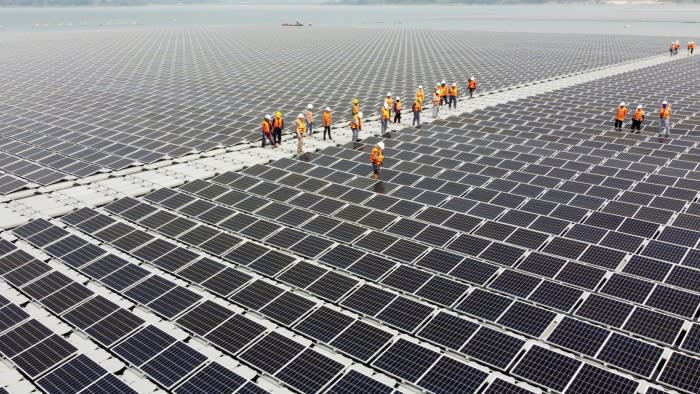Stay informed with free updates
Just log in Renewable energy myFT Digest — delivered straight to your inbox.
The world’s clean energy plans are still barely a third of what is needed to meet a 2030 renewable energy target agreed at UN climate talks last year, the International Energy Agency warned. , as delegates from almost 200 countries meet again in Bonn this week.
Bargaining for a new climate finance deal and improved national pledges to cut greenhouse gas emissions will take place over 10 days at UN talks to lay the groundwork for the COP29 climate summit in Baku in November.
Negotiations will also focus on how to ensure plans agreed at COP28 in Dubai last year are met, including a goal to triple global renewable energy generation capacity to at least 11,000 gigawatts by 2030.
Data released by the IEA on Tuesday shows that countries’ existing policies and estimates mean 8,000 GW of renewable energy will be installed by the end of the decade. Almost 40 percent of this capacity, or 3,180 GW, is made up of China’s plans for solar, wind and hydroelectric power.
The global renewable energy target was “ambitious but achievable – though only if governments quickly turn promises into action plans”, said the agency’s executive director Fatih Birol.
Annual additions of renewable capacity had tripled since the 2015 Paris Agreement to limit global warming, the IEA said, as the cost of solar and wind power fell by 40 percent. Nearly half of the countries assessed have plans to double their renewable energy installation by 2030.
Despite this progress, permitting delays, under-investment and grid infrastructure problems still plague most energy systems.
The pace of clean energy deployment needed to accelerate in most regions, including the EU, the US and India, the IEA said.
“You’re talking about huge hurdles to overcome in terms of finance, grid integration, access to critical minerals, workforce development,” said Alden Meyer, a senior fellow at the climate-focused think tank E3G. “It’s a daunting target and it’s good that there was a political consensus that we need to get there, but now [negotiators] are up to the hard part.”
Updated national decarbonisation plans that countries must submit to the UN by early 2025 should include more detail on their targets to increase renewable energy, the IEA report recommended.
Kicking off meetings in Bonn marking the halfway point for COP29 on Monday, UN climate chief Simon Stiell said the planet was on track for a “disastrous high” rise in global temperature of 2.7C in the industrial era.
The discussions started against a weak background. The German government’s climate adviser, the Expert Council on Climate Change, said it was unlikely to meet its target of cutting emissions by 65 percent by 2030 compared to 1990 levels. This is despite a slowdown in production that has contributed to the reduction of the country’s emissions in the past year.
Flood warnings have also been issued for many parts of Germany this week and the Rhine was closed to shipping where water levels were too high. Areas of the country have experienced periods of extreme rainfall since the start of the year, in line with global trends.
The first day of talks was interrupted by protesters carrying a Palestinian flag, and was also halted by a complaint by a Russian delegation about access to German visas.
Climate capital

Where climate change meets business, markets and politics. Explore the FT’s coverage here.
Curious about FT’s commitments to environmental sustainability? Learn more about our science-based goals here
